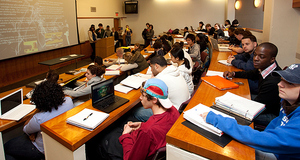From Elon Journal of Undergraduate Research in Communications VOL. 6 NO. 2How University Websites Portray Study AbroadIII. MethodsIn order to answer the research questions, the author collected online rhetoric from five university websites that promote study abroad. Five universities were randomly selected from the U.S. News & World Report Study Abroad Rankings, which rate study abroad programs based on a number of criteria including academics, cultural interactions, lengths of program, and more ("Study Abroad," 2015). Out of the 30 universities rated with exceptional study abroad programs, five were randomly selected, as shown in Table 1. While each university created an extensive website for study abroad in a variety of ways, the author analyzed only web pages that offered general information about study abroad, global or international studies, or study away. Through a rhetorical analysis with close reading, the author examined the visual, verbal, and interactive elements on these websites. Elements such as their overall themes, photographic or other visual messages, language and interactive features of the websites were included in the analysis. IV. Findings & DiscussionContent of websites for study abroad programsThe study revealed many similarities among the five universities analyzed and the ways they promote study abroad. Most of the websites included large photos of students, places, people, and even animals to promote study abroad on their websites. In addition, they all had one or two levels of primary navigation through the study abroad section of the website, with similar content including types of programs, costs, preparation tips, health and safety, important dates, and more. Four out of the five websites included a calendar of events prominently on its study abroad web page. Frequently asked questions and student testimonials from studying abroad were also part of popular website strategies among the universities. Overall, the universities had a variety of verbal, visual, and interactive components to their websites to communicate the study abroad experience and the intercultural competence process. The Changing Rhetoric of "Study Abroad"The concept of study abroad was termed differently by universities. To name their study abroad departments, universities adopted phrases like "overseas programs," "study away," "global studies," "international studies," as well as "study abroad." For example, Stanford University's undergraduate study abroad program is the Bing Overseas Studies Program (BOSP). Macalester College's study abroad program falls under its "International Center," where they promote the "study away experience." Michigan State University (MSU) uses the term "study abroad" most often under its "Office of Study Abroad" department. St. John's University also uses the term "study abroad," while also referring to "global studies" when promoting its programs around the world. While the term "study away" encompasses a broader range of places to study, including international and national locations, a "global studies" program can also refer to a similar concept. Studying "overseas" or "internationally" in a rhetorical sense does not include places within national borders. This shows that within the realm of "international" or "intercultural" education, institutions are rethinking what intercultural experiences mean, whether studying abroad should be an international experience or if studying "away" (within one's own country) could also provide authentic intercultural education. While explaining the presence of buzzwords such as "global competency" and "campus internationalization" involved in the rhetorical frames of college administrations, Reilly and Senders (2009) argued that critical definitions of study abroad and its outcomes should be present in universities' rhetoric (p. 241). In their critique on study abroad, they suggested that universities replace the rhetoric of "internationality" with the idea of "we are all co-inhabitants of a single planet" (p. 250). This view corresponds to terms used on university websites such as "global studies," where studying abroad is seen from a planetary scale. The various terms for study abroad show how universities communicate study abroad on their websites and how they view intercultural experiences whether study abroad is exclusively international program or a global experience. Much of the language used to define an international or intercultural education evokes a sense of traveling to a different place in order to understand different people on both a local and global level. An emphasis on the "local"Despite the intricacies of study abroad terminology, the university websites also provide a rich look into how these intercultural experiences are portrayed. An important aspect of promoting intercultural experiences on these websites focuses on not only the global, but the local. Looking at key themes on the websites gives insight into the values being promoted on study abroad websites: the value of local experiences. The emphasis on local community, people, and environment is found in language in the pre-departure phase before students travel abroad and while students are abroad. Specifically, several universities promote campus events, such as "Your Global Backyard Field Trip" and "Study Abroad in the ‘Hood,'" where students were encouraged to participate in study abroad advising programs or global education programs "right in their backyard." This local emphasis signifies the merging between the local and the global, instilling the idea that forming close connections with the surrounding environment is an important habit when preparing to go abroad and during the actual experience. The emphasis on the local reinforces the idea that intercultural competence is developed through community interaction and must be cultivated intentionally (Bennett, 2011). University websites also promote the local aspect of study abroad through specific examples of experiences students may have abroad. For instance, St. John's University describes its study abroad programs as a way to merge global and local education: "Imagine sitting outside the Coliseum under the sunny Italian sky, drawing a piece of history as part of your ‘Italian Sketchbook' class. Or maybe you're more interested in Paris's ‘Economics of Poverty & Income Inequality' class, through which you'll tackle complex social issues before heading out into the streets to feed the hungry? [sic] No matter the subject, our courses offer you local context—firmly embedded in the host city wherever possible—for understanding the global framework of each discipline" ("Academic and Cultural," 2015). This particular example focuses on local living and becoming immersed in a new environment. Other websites heighten the local aspect by using strong language to describe cultural immersion as an "invaluable" experience or a "once-in-a-lifetime opportunity." Study abroad scholars have also encouraged students and universities to embrace the local and understand the multiple sides of the cultures in their host cities (Reilly & Senders, 2009, p. 253). As a whole, university websites are balancing two different concepts, globalism and locality, a complex but necessary view for explaining and promoting intercultural experiences. Investing in the local community is one value seen through study abroad marketing on these specific university websites, and it gives a clearer picture on how universities communicate intercultural experiences. Framing the outcomes of study abroadAs we compare the rhetoric of university websites to the ideas presented in scholarly research about intercultural competence and global citizenry, it is important to note if and how universities define these concepts specifically on their websites. Out of all five websites, St. John's University specifically mentions "intercultural competence," defines it, and lists its benefits ("Academic and Cultural," 2015). While this definition is not located in a primary part of its study abroad website, it goes into detail about the value of intercultural competence. It also describes its Cultural Mentorship Program as what the university implements to enrich cultural understanding and intercultural competence in students. This web page mentions outcomes of intercultural competence, such as heightened empathy, understanding of different worldviews, strong communication skills, and better awareness of one's own culture and worldview. Other websites specifically outline the intercultural benefits of study abroad. Michigan State University highlights the intercultural outcomes on their website, noting that students "may increase their interests in other cultures, become less ethnocentric . . . develop language skills within a cultural context" ("Why Should I," 2015). The intercultural benefits here also coincide with views of aforementioned Bennett and Deardorff. MSU lists the intercultural benefits alongside other advantages of study abroad, including personal, academic/intellectual, and professional benefits. While the intercultural opportunities are an important aspect integrated into the messages of the university websites, often phrases and visual imagery focus on other benefits for students. This includes emphasis on "high academic performance" and "learning experiences," as well as how study abroad fits into different academic and curriculum requirements. Personal development is also strongly highlighted in the language, with some universities emphasizing that students will receive "personal attention" or students will "deepen awareness of themselves." The verbal rhetoric often seems to favor noting how students can be transformed personally and academically, which suggests a broader impact than just intercultural benefits. Highlighting some benefits over others is one way that websites can frame the reality of the study abroad experience. This also shows how the personal and academic values of the study abroad experience are key themes in university website communication. Intercultural experiences promoted visuallyThe university websites can also be studied by examining the use of images and graphics on the sites. Visually, they used images that portray different aspects of study abroad: personal development, academic achievement, and cultural experiences. The universities usually incorporated large photos on their websites, often in slideshows across the full page. Out of the 52 photos examined on the main study abroad pages of these universities, 13 photos showed individual students in various locations around the world, while another 11 photos featured only landscapes or animals. For example, one showed a female student with a big smile and her hands in the air, overlooking a South African landscape. Another featured a female student sitting on a rock overlooking a dry landscape, with blue skies. Photos like these reflect the notion that study abroad is an individualized experience and that universities work to promote the students' personal development. While cultural selfawareness and personal skills like empathy are important to building intercultural competence (American Association of Colleges and Universities, 2010), interactions between two or more individuals are needed for authentic intercultural learning. Images that portray individual students solitarily do not relay the message that an intercultural exchange involves two or more groups of people coming together. In the end, students' learning cannot happen solitarily, but rather with others. Other photos on university websites promoted intercultural benefits further, such as images of student groups and faculty interacting with local people abroad. Out of the 52 images, 9 portrayed students interacting with non-students from a host country. As a whole, many of these images included photos of people in different cultures with various skin colors, dressed in traditional ethnic clothing. The images relate to Bishop's (2013) description that study abroad can promote the message that "travel abroad allows students to encounter welcoming, exotic ‘others' who willingly provide glimpses into areas of the world previously known" (p. 403). In addition, the images on the website support Bishop's (2013) analysis of learning environments abroad. Only four photos depicted indoor environments, which can lead to study abroad marketing to "deemphasize traditional university learning environments" (p. 403). Promoting images of outdoor environments suggests that study abroad encourages fieldwork, cultural experiences, and learning opportunities beyond the classroom, which may lead to intercultural interactions that develop in various authentic settings. Taken as a whole, the images on study abroad websites feature bright, positive images and undermine the struggles that students may face while studying abroad, such as culture shock and anxiety. While the visual rhetoric on university websites does represent intercultural reasons for studying abroad, the photos can suggest different realities of the study abroad experience, perhaps framing a more educational touristic experience for students. This suggests that diverse aspects of the intercultural benefits should be promoted to a greater extent on university websites. Continuing conversations: interactive study abroad marketingThe universities incorporate interactivity in their websites, with which users continue the conversation about study abroad. According to Sharp's (2001) theory of positive response action for website communication, websites aim to produce positive actions from visitors such as staying on the site longer, clicking through various information, and engaging with the content (p. 42). The five university websites employ interactivity in the form of interactive maps, blogs, social media boxes, calendars, and videos so that they can continue the conversation about study abroad, especially with students who are in the preparation phase of the study abroad process. The interactive websites can reinforce the messages of study abroad and the experience that universities are marketing to students. For example, Stanford University displays its global reach in the form of an interactive map on its website. This "Global Explorer" map allows users to see how the university reaches different parts of the world, with clickable red icons to symbolize locations where Stanford students and faculty have studied abroad, conducted research, and organized events ("Explore Stanford," 2015). Interactive websites allow universities to sound less like a sales pitch and more like a community of people coming together. It makes study abroad sound less like a tourism package with a postcard view, a onesided perspective of an experience. Thus, universities should use this interactive marketing approach to complement a multi-faceted intercultural study abroad experience. Interactive tools inspire students and other users to come back to the website for updated information. In addition, social media and blog content often promote authentic and user-generated stories to inform and connect with publics. Four of the five university study abroad departments included study abroadspecific social media channels on their web pages. Also, four out of the five websites featured a calendar section with upcoming events to update visitors. Michigan State University includes an "International News" section, with a curated list of recent articles from reputable news sources, such as The Chronicle, USA Today, and The Atlantic. Having a stream of updated information allows website visitors to engage with new content from a variety of sources. Through updating content and reinforcing the idea that many other organizations and groups of people are talking about study abroad, the universities increase the dialogic elements of their websites. The dialogic nature of the websites complements the idea that students gain experience by having engaging conversations with people from a variety of perspectives. The increasingly interactive nature of study abroad marketing creates an environment that encourages students to explore, build connections and learn from others, all crucial parts of an intercultural journey. By exploring the interactive, visual and textual elements of these websites, this study shows how values like local community, engaging conversations, and students' personal development are part of study abroad website marketing. The rhetorical analysis of these websites shows the various ways in which intercultural experiences and other values are promoted across different universities. There were several limitations to this analysis on study abroad websites. Among others, the content produced for these university websites cannot be generalized to those of the 30 ranked in the U.S. News & World Report, let alone the study abroad programs of all universities. Considering the evolving interactivity and dynamic nature of digital marketing techniques for study abroad programs, future studies may examine other online artifacts beyond what this study analyzed. The use of Twitter, Instagram, Facebook, YouTube, and other new social media channels is becoming the norm for many universities when marketing their study abroad programs. Research on how study abroad departments use these media to connect with students and other key publics may help understand the marketing landscape of study abroad. V. ConclusionIn conclusion, university websites can frame the study abroad experience in a variety of ways. An analysis of the textual, visual, and interactive elements used online is important to understand how students view the purpose and benefits of study abroad for personal, cultural, and academic reasons. This analysis determined that universities use several means to communicate study abroad on their websites including the use of images of people and travel destinations; interactive content such as maps, calendars and news; student testimonials; and descriptive examples of study abroad experiences. The websites revealed that universities use particular terms to define their study abroad programs, such as "global studies" or "overseas studies," which provide different rhetorical contexts for promoting intercultural experiences. The study also analyzed to what extent the intercultural benefits of study abroad were featured on university websites. While the intercultural aspects of study abroad are highlighted on the five university websites, only one specifically mentioned scholarly definitions of intercultural competence and its benefits to students. In many cases, the emphasis of personal and academic benefits for students outweighed the intercultural aspects of studying abroad. Other values promoted through the university websites include the importance of getting "local," providing interactive outlets for conversations, and building global communities. As seen through these particular web pages, study abroad marketing could often promote a postcard view of an experience, highlighting particular outcomes of student experiences over others. A wider study would be necessary in order to draw more generalized conclusions on how university websites portray the intercultural experiences of study abroad. AcknowledgmentsThe author would like to extend thanks to Michael Frontani, associate professor of communications at Elon University, for his guidance, inspiration, and advice, without all of which the article could not be published. The author is also thankful to Stephen Braye, professor of English at Elon University, for inspiring deeper research into the study abroad experience. AuthorGina Apperson, Strategic Communications, Elon University ReferencesAcademic and Cultural Advantage. (2015). St. John's University. Retrieved April 12, 2015, from http://www.stjohns.edu/global/study-abroad/academic-and-cultural-advantage American Association of Colleges and Universities. (2010). Intercultural knowledge and competence value rubric. Bennett, J. M. (2008).Transformative training: Designing programs for culture learning. In M.A. Moodian (Ed.), Contemporary leadership and intercultural competence: Exploring the Cross-Cultural Dynamics Within Organizations (pp. 95-110). London, United Kingdom: Sage. Bennett, J. M. (2011, February). Developing intercultural competence for international education faculty and staff. Presentation at the AIEA Leaders in International Higher Education Conference, San Francisco, CA. Bishop, S. C. (2013). The Rhetoric of study abroad: Perpetuating expectations and results through technological enframing. Journal Of Studies In International Education, 17(4), 398-413. Caton, K., & Santos, C. A. (2009). Images of the Other: selling study abroad in a postcolonial world. Journal Of Travel Research, 48(2), 191-204. Clarke, I. I., Flaherty, T. B., Wright, N. D., & McMillen, R. M. (2009). Student intercultural proficiency from study abroad programs. Journal Of Marketing Education, 31(2), 173-181. Deardorff, D.K. (2010). Intercultural competence in higher education and intercultural dialogue. In S. Bergan, H. van't Land (Ed.). Speaking across borders: The role of higher education in furthering intercultural dialogue. Council of Europe. Designating 2006 as the "Year of Study Abroad." S. Res. 308, 109th Cong., 3rd Sess. (2005). Doerr, N. M. (2012) Study abroad as ‘adventure': globalist construction of host–home hierarchy and governed adventurer subjects. Critical Discourse Studies, 9(3), 257-268. Explore Stanford: Go global. (2015) Stanford University Retrieved April 12, 2015, from https://goglobal.stanford.edu/explore/map Framing. (2010). Communication theory. Retrieved March 27, 2015, from http://communicationtheory.org/framing/ Franklin, K. (2010). Long-Term career impact and professional applicability of the study abroad experience. Frontiers: The Interdisciplinary Journal of Study Abroad, 19, 169-190. Generation Study Abroad. (2015). Institute of International Education, Inc. Retrieved March 27, 2015, from http://www.iie.org/Programs/Generation-Study-Abroad Goffman, E. (1974). Frame analysis: An essay on the organization of experience. Harvard University Press. Gordon, J., & Berhow, S. (2009). University websites and dialogic features for building relationships with potential students. Public Relations Review, 35(2), 150-152. doi:10.1016/j.pubrev.2008.11.003 Green, M. F., Luu, D., & Burris, B. (2008). Mapping internationalization on U.S. campuses: 2008 edition. Washington, DC: American Council on Education. Retrieved March 15 from http://www.acenet.edu/news-room/Documents/2008-Mapping-Highlights.pdf History and purposes of study abroad. (2012). ASHE Higher Education Report, 38(4), 13-26. Holoviak, J., Verney, T., Winter, A., & Holoviak, S. (2011). Assessing academic performance through study abroad: Benefits of the experience. Research in Higher Education Journal, 11. 1-10. Institute of International Education. (2014). Open doors data: Fast facts. Retrieved March 7, 2015, from http://www.iie.org/Research-and-Publications/Open-Doors/Data/Fast-Facts Li, M., Olson, J. and Frieze, H. (2013). Students' study abroad plans: The Influence of motivational and personality factors. Frontiers: the Interdisciplinary Journal of Study Abroad, XXIII(Fall 2013), 73-89. Lukosius, V., & Festervand, T. A. (2013). Marketing study abroad programs: A student recruitment model. American Journal of Business Education (AJBE), 6(5), 483-494. Reilly, D. & Senders, S. (Fall 2009). Becoming the change we want to see: Critical study abroad for a tumultuous world. Frontiers: the Interdisciplinary Journal of Study Abroad, XVIII, 241-267. Sharp, L. (2001). Positive response action: The ultimate goal of website communication. Journal Of Communication Management, 6(1), 41-52. Study Abroad. (2015, January 1). U.S. News & World Report LP. Retrieved March 15, 2015, from http://colleges.usnews.rankingsandreviews.com/best-colleges/rankings/study-abroad-programs. Williams, T. (Winter 2012-Spring 2013). Examine your LENS: A tool for interpreting cultural differences. Frontiers: The Interdisciplinary Journal of Study Abroad, 22, 148-165. Retrieved February 22, 2015, from http://www.frontiersjournal.com/ Why should I study abroad? (2015). Michigan State University. Retrieved April 12, 2015, from http://studyabroad.isp.msu.edu/shared/objectives.html Yoo, S. and Jin, J. (2004). Evaluation of the home page of the top 100 university web sites. Academy of Information and Management Sciences, 8(2), 57–69. University Websites Included in the AnalysisAbout – International Center. (2015). Macalester College. Retrieved April 12, 2015, from http://www.macalester.edu/internationalcenter/about/ Academic and cultural advantage. (2015). St. John's University. Retrieved April 12, 2015, from http://www.stjohns.edu/global/study-abroad/academic-and-cultural-advantage Bing overseas studies program. (2015). Stanford University. Retrieved April 12, 2015, from https://undergrad.stanford.edu/programs/bosp/explore/study-abroad-overview Global explorer. (2015). Stanford University. Retrieved April 12, 2015, from https://goglobal.stanford.edu/explore/map Global studies. (2015). St. John's University. Retrieved April 12, 2015, from http://www.stjohns.edu/globalstudies International Center. (2015). Macalester College. Retrieved April 12, 2015, from http://www.macalester.edu/internationalcenter/ Life and learning around the globe. (2015). St. John's University. Retrieved April 12, 2015, from http://www.stjohns.edu/global Office of Study Abroad. (2015). Michigan State University. Retrieved April 12, 2015, from http://studyabroad.isp.msu.edu/ Office of Study Abroad | About us. (2015). Michigan State University. Retrieved April 12, 2015, from http://studyabroad.isp.msu.edu/about/ Stanford go global. (2015). Stanford University. Retrieved April 12, 2015, from https://goglobal.stanford.edu/ Study abroad. (2015). Centre College. Retrieved April 12, 2015, from http://www.centre.edu/about/studyabroad/ Study abroad. (2015). Macalester College. Retrieved April 12, 2015, from http://www.macalester.edu/about/whymacalester/studyabroad/ Study abroad overview. (2015). Stanford University. Retrieved April 12, 2015, from https://undergrad.stanford.edu/programs/bosp Why should I study abroad?. (2015). Michigan State University. Retrieved April 12, 2015, from http://studyabroad.isp.msu.edu/shared/objectives.html Why Study Abroad. (2015). St. John's University. Retrieved April 12, 2015, from http://www.stjohns.edu/global/study-abroad/why-study-abroad Suggested Reading from Inquiries Journal
Inquiries Journal provides undergraduate and graduate students around the world a platform for the wide dissemination of academic work over a range of core disciplines. Representing the work of students from hundreds of institutions around the globe, Inquiries Journal's large database of academic articles is completely free. Learn more | Blog | Submit Latest in Education |




















